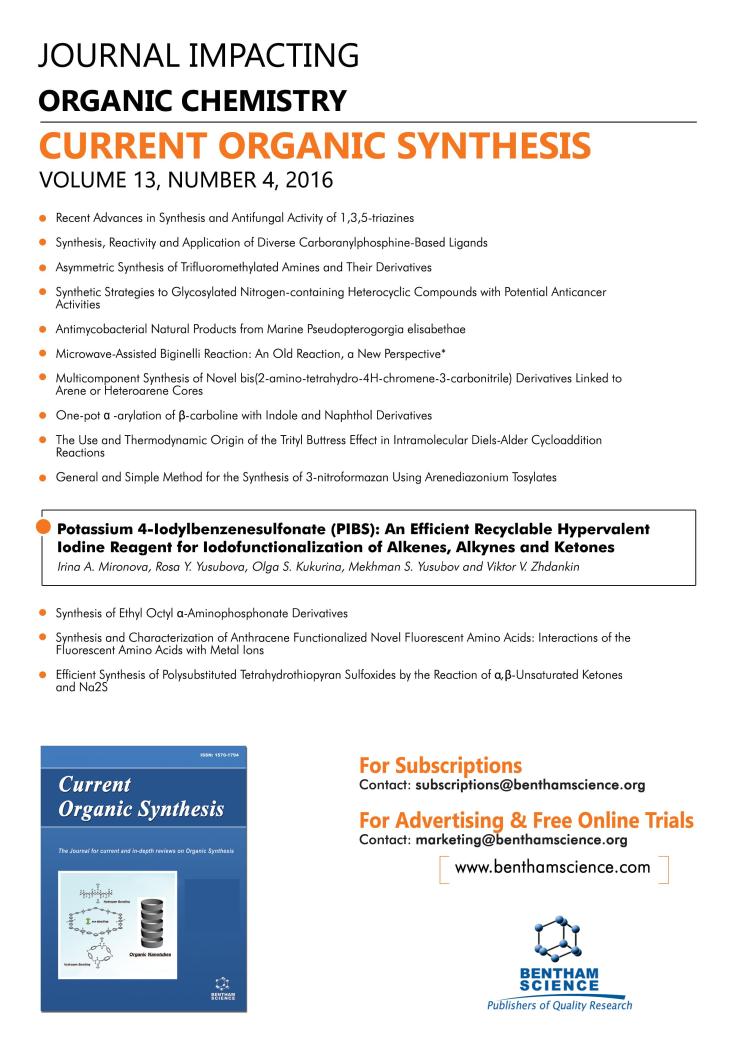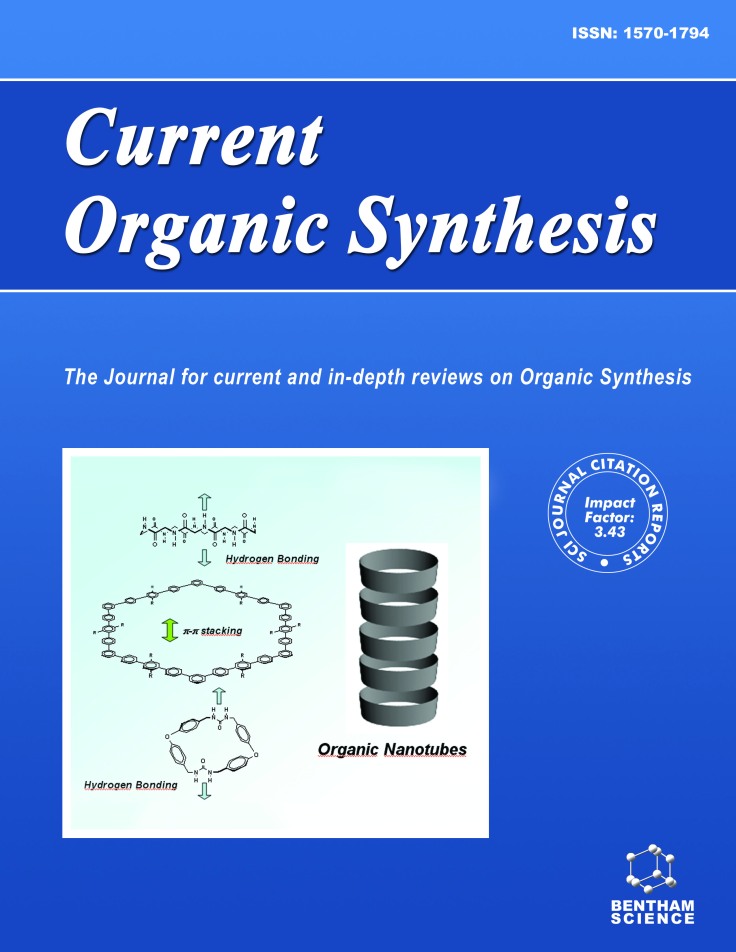Thursday, 29 December 2016
Thursday, 22 December 2016
Monday, 19 December 2016
Thursday, 15 December 2016
Friday, 9 December 2016
Thursday, 1 December 2016
Thursday, 24 November 2016
Monday, 21 November 2016
Friday, 11 November 2016
Call For Paper
03:40
No comments
Bentham Science Publishers would like to invite you to submit your research paper for publishing in the Journal of
Thursday, 3 November 2016
Highlighted Artcile: Propylene Carbonate in Organic Synthesis: Exploring its Potential as a Green Solvent
03:51
No comments
Propylene Carbonate in Organic Synthesis: Exploring its Potential as a Green Solvent
Author(s):
Josué S. Bello Forero, July A. Hernández Muñoz, Joel Jones Junior and Flavia M. da Silva Pages 834 - 846 ( 13 )
Abstract:
Propylene carbonate (PC) is a polar aprotic substance with very similar physicochemical characteristics to the organic solvents traditionally used for organic synthesis, such as acetonitrile and acetone. Therefore, PC is beginning to be used as a “green” sustainable alternative solvent for chemical transformations. PC is a low toxicity, non-corrosive colourless liquid with a high boiling point and low vapour pressure. It is biodegradable and economical, allowing its large-scale use. PC can be prepared by a reaction between propylene epoxide and carbon dioxide with 100% atomic economy. The easy preparation of propylene epoxide and the use of an available, abundant, economical, and renewable source of carbon, such as CO2, make this process one of the best routes for the synthesis of PC. Therefore, we present in this review numerous catalytic systems that have been studied to improve the efficiency of this reaction. Certain interesting examples of reactions using PC are found in the literature, of which we discuss asymmetric hydrogenation, hydrosilylation, asymmetric aldol reactions, the asymmetric synthesis of cyanohydrins, the synthesis of heterocyclic compounds, such as bisindole and tetrahydroquinoline, the hydroacylation of alkynes, α-hydrazination reactions, oxidations, the Sonogashira reaction, allylic alkylation and asymmetric amination, the Heck reaction, enzymatic kinetic resolution, and isomerisation-hydroformylation reactions.
Keywords:
Propylene carbonate, carbonic acid diesters, green chemistry, green solvent, organic synthesis, environment.
Affiliation:
Síntese Orgânica Ambiental SOA - Dept. Química Orgânica - Instituto de Química – UFRJ - CP 68.584, 21941-972, Rio de Janeiro, RJ, Brazil.
For More Information Please Visit Our Website Current Organic Synthesis
Wednesday, 26 October 2016
Most Cited Article: Chlorins: Natural Sources, Synthetic Developments and Main Applications
23:27
No comments
Chlorins: Natural
Sources, Synthetic Developments and Main Applications
Author(s):
Kleber T. de Oliveira, Patrícia B. Momo,
Francisco F. de Assis, Marco A.B. Ferreira and Timothy J. BrocksomPages 42-58
(17)
Abstract:
Chlorin derivatives have attracted considerable attention over the last three decades in different scientific fields. These compounds are present in a large number of bacteria, fungi and in all plants found on Earth. Since the discovery of these pigments, chemists, biologists, medical professionals and materials scientists have devoted pronounced efforts in order to develop new synthetic methods and discover useful applications for these compounds. In this review we wish to cover the main natural chlorins, their natural sources, synthetic approaches to access these compounds, and the major applications.
Keywords:
Chlorin, chlorophylls, porphyrinoid, PDT,
solar cells and natural dyes.
Affiliation:
Departamento de Química, Universidade Federal
de Sao Carlos, Rodovia Washington Luís, km 235 - SP-310, 13565-905, Sao Carlos
- SP – Brazil.
Thursday, 20 October 2016
Thursday, 13 October 2016
Computation-Assisted Disconnection Approach for the Synthesis of Neoantimycins
02:39
No comments
Current Organic Synthesis, Volume 13 (E-pub ahead of print)
Author(s): Shuhei Yamakoshi, Masako Okamoto, Hiroaki Sawamoto, Yuuki Arai, Eiji Kawanishi, Michiko Sasaki and Kei Takeda.
Affiliation: Department of Synthetic Organic Chemistry, Institute of Biomedical and Health Sciences, Hiroshima University, 1-2-3 Kasumi, Minami-ku, Hiroshima 734-8553, Japan.
Abstract
A combination of DFT calculations and MD simulations provides a powerful tool for selecting the most favorable precursor in disconnection analysis of macrolactones that are comprised of several hydroxy acid subunits. The results of examination of the approach for the synthesis of prunustatin A (1) and the application to the synthesis of neoantimycin (2) are described.Keywords:
Neoantimycin, Prunustatin A, Macrocyclization, DFT calculation, MD simulation.
Order Eprints Rights and Permissions
Wednesday, 5 October 2016
New Issue ::: Current Organic Synthesis , 13 Issue 4
10:08
No comments
Current Organic Synthesis publishes in-depth reviews, original research articles and letter/short communications on all areas of synthetic organic chemistry i.e. asymmetric synthesis, organometallic chemistry, novel synthetic approaches to complex organic molecules, carbohydrates, polymers, protein chemistry, DNA chemistry, supramolecular chemistry, molecular recognition and new synthetic methods in organic chemistry. The frontier reviews provide the current state of knowledge in these fields and are written by experts who are internationally known for their eminent research contributions. The journal is essential reading to all synthetic organic chemists. Current Organic Synthesis should prove to be of great interest to synthetic chemists in academia and industry who wish to keep abreast with recent developments in key fields of organic synthesis.
Articles from the journal Current Organic Synthesis , 13 Issue 4
- Recent Advances in Synthesis and Antifungal Activity of 1,3,5-triazines
- Synthesis, Reactivity and Application of Diverse Carboranylphosphine-Based Ligands
- Asymmetric Synthesis of Trifluoromethylated Amines and Their Derivatives
- Synthetic Strategies to Glycosylated Nitrogen-Containing Heterocyclic Compounds with Potential Anticancer Activities
- Antimycobacterial Natural Products from Marine Pseudopterogorgia elisabethae
- Microwave-Assisted Biginelli Reaction: An Old Reaction, a New Perspective
- Multicomponent Synthesis of Novel bis(2-amino-tetrahydro-4H-chromene-3- carbonitrile) Derivatives Linked to Arene or Heteroarene Cores
- One-pot α-arylation of β -carboline with Indole and Naphthol Derivatives
- The Use and Thermodynamic Origin of the Trityl Buttress Effect in Intramolecular Diels-Alder Cycloaddition Reactions
- General and Simple Method for the Synthesis of 3-nitroformazan Using Arenediazonium Tosylates
- Potassium 4-Iodylbenzenesulfonate (PIBS): An Efficient Recyclable Hypervalent Iodine Reagent for Iodo-functionalization of Alkenes, Alkynes and Ketones
- Synthesis of Ethyl Octyl α-Aminophosphonate Derivatives
- Synthesis and Characterization of Anthracene Functionalized Novel Fluorescent Amino Acids: Interactions of the Fluorescent Amino Acids with Metal Ions
- Efficient Synthesis of Polysubstituted Tetrahydrothiopyran Sulfoxides by the Reaction of α,β -Unsaturated Ketones and Na2S
For details on the articles, please visit this link :: http://bit.ly/2clki78
courtesy by https://benthamsciencepublishers.wordpress.com/2016/09/17/new-issue-current-organic-synthesis-13-issue-4/
Highlighted Article Flyer for the journal “Current Organic Synthesis” Volume 13, Number 4, 2016
10:07
No comments

Courtesy by https://benthamsciencepublishers.wordpress.com/2016/07/12/highlighted-article-flyer-for-the-journal-current-organic-synthesis/
Current Organic Synthesis, 13 Issue 3
10:06
No comments
Current Organic Synthesis publishes in-depth reviews, original research articles and letter/short communications on all areas of synthetic organic chemistry i.e. asymmetric synthesis, organometallic chemistry, novel synthetic approaches to complex organic molecules, carbohydrates, polymers, protein chemistry, DNA chemistry, supramolecular chemistry, molecular recognition and new synthetic methods in organic chemistry. The frontier reviews provide the current state of knowledge in these fields and are written by experts who are internationally known for their eminent research contributions. The journal is essential reading to all synthetic organic chemists. Current Organic Synthesis should prove to be of great interest to synthetic chemists in academia and industry who wish to keep abreast with recent developments in key fields of organic synthesis.

Articles from the journal in Current Organic Synthesis, 13 Issue 3
- Developments of Corey-Chaykovsky in Organic Reactions and Total Synthesis of Natural Products
- Natural Naphthoquinones with Great Importance in Medicinal Chemistry
- Illustrations of Efficient Solar Driven Organic Reactions
- Applications of Indan-1,3-Dione in Heterocyclic Synthesis
- Synthesis and Chemical Behavior of 1,2,4-Triazine Derivatives Bearing Phosphorus Amides as Donor-Acceptors: A Review
- Synthesis of New Furo-Imidazo[3.3.3]propellanes
- Propylene Carbonate as a Solvent in the Eco-Friendly Synthesis of Highly Substituted Imidazoles Through the Radziszewski Reaction
- Brønsted Acid Catalyzed Peptide Synthesis through Azlactone Rings
- Hydrazonoyl Halides as Precursors for Synthesis of Bioactive Thiazole and Thiadiazole Derivatives: Synthesis, Molecular Docking and Pharmacological Study
- Synthesis of New Thiazole Derivatives as Antitumor Agents
- New Imidazolidineiminothione, Imidazolidin-2-one and Imidazoquinoxaline Derivatives: Synthesis and Evaluation of Antibacterial and Antifungal Activities
- The Cyanation of Prochiral Aldehydes with Chiral Copper Complexes of R-(+)/S-(-) -α-Ethylphenyl Amine in Methanol
For details on the articles, please visit this link :: http://bit.ly/1VVim3D
courtesy by https://benthamsciencepublishers.wordpress.com/2016/05/13/new-issue-current-organic-synthesis-13-issue-3/
Current Organic Synthesis, 12 issue 6
10:06
No comments

Current Organic Synthesis publishes in-depth reviews, original research articles and letter/short communications on all areas of synthetic organic chemistry i.e. asymmetric synthesis, organometallic chemistry, novel synthetic approaches to complex organic molecules, carbohydrates, polymers, protein chemistry, DNA chemistry, supramolecular chemistry, molecular recognition and new synthetic methods in organic chemistry. The frontier reviews provide the current state of knowledge in these fields and are written by experts who are internationally known for their eminent research contributions. The journal is essential reading to all synthetic organic chemists. Current Organic Synthesis should prove to be of great interest to synthetic chemists in academia and industry who wish to keep abreast with recent developments in key fields of organic synthesis.
Articles from the journal Current Organic Synthesis, 12 issue 6:
- Editorial (Thematic Issue: Organic Synthesis in Brazil: Past, Present and Future (Part 2)) Application of Bio-Based Solvents in Catalysis
- Contributions on Kinetic Resolution by Lipases on the Development of Organic Synthesis in Brazil
- Drug Likeness and Selective Functionalization of Quinoxalines
- Novel Synthetic Compounds as Potential Anticryptococcal Agents
- Synthetic Strategies for the Preparation of Butenolides and Their Transformation into Other Derivatives
- Palladium-Catalyzed Oxyarylation, Azaarylation and α-Arylation Reactions in the Synthesis of Bioactive Isoflavonoid Analogues
- Recent Advances in the Asymmetric Claisen Rearrangement Promoted by Chiral Organometallic Lewis Acids or Organic Bronsted-Lowry Acids
- Importance of Organic Synthesis in the Development of Liquid Crystals
- Copper-Catalyzed One-Pot Multicomponent Reactions: Synthesis of 4-Arylsulfenyl Pyrazoles
- The Morita-Baylis-Hillman Reaction: Advances and Contributions from Brazilian Chemistry
For details, please visit: http://bit.ly/1FOOslL
courtesy by https://benthamsciencepublishers.wordpress.com/2015/11/12/new-issue-current-organic-synthesis-12-issue-6/
Contributions by Japanese authors in Bentham Science journal ‘Current Organic Synthesis’
10:04
No comments
Synthesis of Asymmetric Diaryl Sulfides by SNAr Reaction of Substituted Nitrobenzene with Aryl Disulfides
Author(s): Naoki Enjo, Rong Lu and Tetsuo Miyakoshi.
Abstract: A series of sulfides was successfully synthesized from nitroarenes by SNAr reaction via elimination of a nitro or phenylsulfonyl group. The SNAr reaction mechanism is found to depend on the position and type of substituents, and the effect of two-electron withdrawing groups was also examined.
Two Neglected Multicomponent Reactions: Asinger and Groebke Reaction for Constructing Thiazolines and Imidazolines
Author(s): Zai-Qun Liu.
Abstract: The multicomponent reaction (MCR) is an important research field in the organic synthetic methodology. In 1956, Professor Friedrich Asinger reported a method for synthesizing thiazoline scaffold, in which a ketone was treated by sulfur and ammonia in one-pot operation. In 1998, Professor Katrin Groebke, Hugues Bienayme, and Christopher Blackburn reported a method for preparing imidazo[1,2-a]pyridine, in which an annulation took place among α- aminopyridine, aldehyde, and isocyanide in one-pot operation, and then the reaction was entitled as Groebke reaction. Comparing with the bloom in the research of other MCRs such as Strecker (found in 1850), Hantzsch (1882), Biginelli (1891), Mannich (1912), Passerini (1921) and Ugi (1959) MCR, as newcomers in the family of MCR, Asinger and Groebke reactions are not reported as usually as other MCRs. The aim of the present review is to emphasize the importance of these two MCRs in the synthesis of thiazolines and imidazolines.
Read more here: http://benthamscience.com/journals/current-organic-synthesis/volume/12/issue/1/page/20/
courtesy by https://benthamsciencepublishers.wordpress.com/2015/08/24/contributions-by-japanese-authors-in-bentham-science-journal-current-organic-synthesis/
Substantial contributions to Bentham Science Journal Current Organic Synthesis by Indian Authors
10:03
No comments
Multicomponent 1,3-Dipolar Cycloaddition Reactions in the Construction of Hybrid Spiroheterocycles
Author(s):NatarajanArumugam, RajuSuresh Kumar, Abdulrahman I. Almansour and SubbuPerumal
Pages 1929-1956 (28)
Abstract:
Spiroheterocyclic ring systems are attractive synthetic targets due to their interesting conformational features and their structural implications on their activity in biological systems. Consequently, a vast deal of research by synthetic organic as well as medicinal chemists pertains to the synthesis of these heterocycles employing diverse synthetic methodologies. Among them, one-pot multicomponent 1,3-cycloaddition reactions have emerged as preferred synthetic protocol in view of their convergence, atom economy, ecofriendliness, flexibility and facile automation. This review article focuses on the assembly of mono-, di- and multispiro heterocyclic hybrids via aforesaid synthetic methodologies with a variety of dipolarophiles.
Palladium Catalyzed C–H Activation and its Application to Multi-bond Forming Reactions
Author(s): Krishnan Ramachandiran, Thonthula Sreelatha, Neelakandan V. Lakshmi, Thelagathoti H. Babu, Doraiswamy Muralidharan and Paramasiram T. Perumal
Pages 2001-2024 (24)
Pages 2001-2024 (24)
Abstract:
The focus of the review is on the formation of multiple bonds by palladium catalyzed C-H activation and functionalization. These include alkanylation, alkenylation, arylations, annulations, domino, cascade reaction, coupling and synthesis of spiro compounds. The non-synchronous formation of new carbon-carbon and carbon-heteroatom (N, O) bonds for the construction of various heterocycles is also discussed.
L-Proline Catalysed Domino Reactions for the Synthesis of Heterocycles
Author(s): Sethuraman Indumathi, Jose C. Menendez and Subbu Perumal
Pages 2038-2064 (27)
Pages 2038-2064 (27)
Abstract:
L-Proline is a cheap, water-soluble organocatalyst that is able to induce the synthesis of a large number of heterocyclic systems. This work is reviewed, with emphasis on the literature of the 2005-2011 period. The domino reactions have been classified according to the nature of the first step of their proposed mechanisms, as follows: (i) iminium-initiated domino mechanisms; (ii) enamineinitiated domino mechanisms; (iii) reactions proceeding via the intermediacy of dienamines; (iv) reactions in which proline acts as a Lewis base and (v) L-proline/metal catalysed reactions.
courtesy by https://benthamsciencepublishers.wordpress.com/2015/08/07/substantial-contributions-to-bentham-science-journal-current-organic-synthesis-by-indian-authors/
High Impact Factor Journal:::Current Organic Synthesis
10:02
No comments
Current Organic Synthesis publishes in-depth reviews, original research articles and letter/short communications on all areas of synthetic organic chemistry i.e. asymmetric synthesis, organometallic chemistry, novel synthetic approaches to complex organic molecules, carbohydrates, polymers, protein chemistry, DNA chemistry, supramolecular chemistry, molecular recognition and new synthetic methods in organic chemistry. The frontier reviews provide the current state of knowledge in these fields and are written by experts who are internationally known for their eminent research contributions. The journal is essential reading to all synthetic organic chemists. Current Organic Synthesis should prove to be of great interest to synthetic chemists in academia and industry who wish to keep abreast with recent developments in key fields of organic synthesis.
Abstracted & Indexed in:
Science Citation Index Expanded (SciSearch®), Journal Citation Reports/Science Edition, Chemistry Citation Index®, ISI Alerting Services, Current Contents® / Physical, Chemical and Earth Sciences, BIOSIS Previews, BIOSIS Review Report and Meetings, Scopus, Chemical Abstracts, ProQuest, PubsHub, MediaFinder®-Standard Periodical Directory, Genamics JournalSeek and J-Gate.
courtesy by https://benthamsciencepublishers.wordpress.com/2015/07/28/high-impact-factor-journalcurrent-organic-synthesis/
Wednesday, 10 August 2016
The Synthesis of Novel Oxazolinylphosphinic Esters and Amides and Application to the Cyanosilylation of Aldehydes
02:24
No comments
Author(s):
Mei LuoPages 660-672 (13)
Abstract:
A new class of modular functionalized oxazolines are synthesized using a simple, novel one-pot method under inert moisture-free conditions. Then the oxazolines can be further elaborated to phosphine-containing oxazolines. The first step is to synthesize intermediates via the reaction of 2 - hydroxybenzonitrile or 2- aminobenzonitrile with chiral amino alcohols, subsequent reactions with phosphine chlorides, providing products in moderate yields. Product structures are fully characterized by NMR, IR, MS and X-Ray analyses. These compounds are found to be highly active catalysts for the cyanosilylation of prochiral benzaldehyde (20-96% yield).
Keywords:
Functionalized oxazolines, chiral organometallic complexes, 2-hydroxybenzonitrile, 2- aminobenzonitrile, chiral amino alcohols, phosphine chlorides.
Affiliation:
Hefei University of Technology, Department of Chemical Engineering, Hefei, 230009, China.
Graphical Abstract:
Read Full-Text article
New Imidazolidineiminothione, Imidazolidin-2-one and Imidazoquinoxaline Derivatives: Synthesis and Evaluation of Antibacterial and Antifungal Activities
02:23
No comments
Author(s):
Yousry A. Ammar, Marwa A. M. Sh. El-Sharief, Mostafa M. Ghorab, Yehia A. Mohamed, Ahmed Ragab and Samir Y. AbbasPages 466-475 (10)
Abstract:
A series of new 5-imino-4-thioxo-2-imidazolidinone derivatives 3 with various halogenated and alkylated aromatic substituents at N1and N3 was synthesized. Imidazolidineiminothione derivatives 3 were prepared from the reaction of N-arylcyanothioformamide derivatives with aryl isocyanates. These compounds were used as key synthons for the preparation of wide variety of new substituted imidazole compounds. Imine hydrolysis of 3 with ethanolic HCl produced the corresponding 4-thioxo-2,5-imidazolidindiones 4. Condensation of 3 with benzophenonhydrazone furnished the corresponding 4-azine derivatives 5. Monohydrazono and dihydrazono derivatives 6 and 8 were obtained upon treatment of imidazolidinone derivatives 3 with hydrazine hydrate. Finally, imidazolidinones 3 were reacted with o-phenylenediamines or pyrazol- 5(4H)-ones and afforded the corresponding imidazoquinoxaline and imidazolidin-4-ylidenepyrazolone-5(4H)-one derivatives 11 and 12, respectively. Evaluation of the antibacterial and antifungal activities for the synthesized compounds was carried out to probe their activities. Most of the tested compounds showed significant activities. The best antimicrobial activity was observed for 1-(3-ethoxyphenyl)-6- methyl-1-phenyl-1H-imidazo[4,5-b]quinoxalin-2(3H)-ones (11c) followed by 5-imino-3-(3-methoxy- phenyl)-1-phenyl-4- thioxoimidazolidin-2-one (3f).
Keywords:
N-arylcyanothioformanilides, imidazolidineiminothiones, imidazolidinone, imidazoquinoxaline, antibacterial and antifungal activities.
Affiliation:
Pharmacognosy Department, College of Pharmacy, King Saud University, P.O. Box 2457, Riyadh 11451, Saudi Arabia.
Read Full-Text article





















